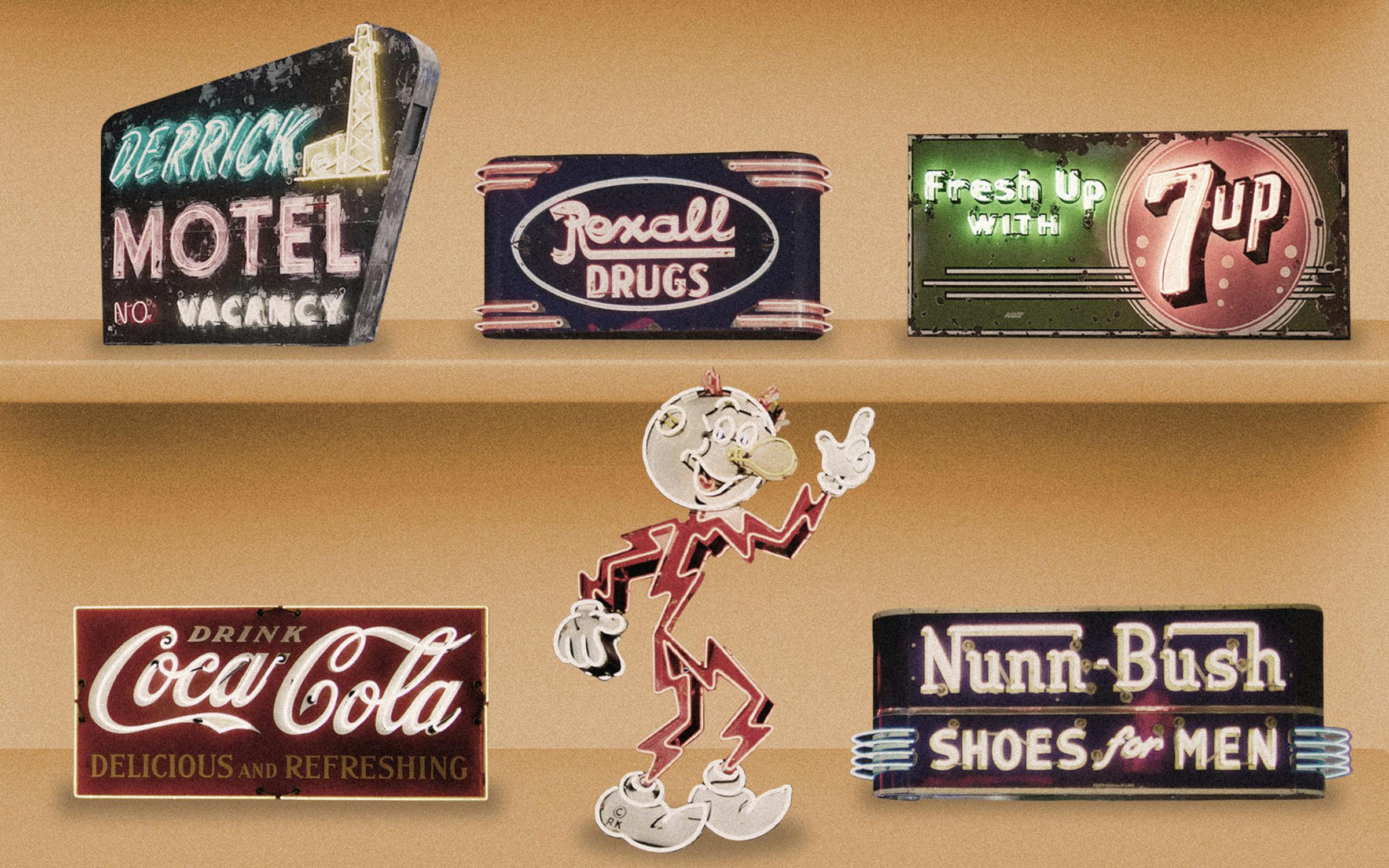The collection
More than 250 historic signs.
Years in the making
Thirty.
Most expensive acquisition
A 1920s Buick sign from a museum in Minnesota. “I could have bought a brand-new Corvette for what that one cost.”
Most difficult to restore
A 24-by-14-foot Coca-Cola sign that has towered over Abilene’s downtown since the 1940s. With 590 bulbs to rewire and damage from decades of exposure to the harsh West Texas weather, the restoration took seven months to complete.
As the sun sets on Abilene, Robert Hoemke’s latest obsession is just coming to life. His 100-plus neon signs—favorites among his 250-strong sign collection—dance and flicker, illuminating the windows of D&W Underground, Hoemke’s downtown event center. His 1903 “Ice Light Power” sign once adorned Abilene’s original power plant. Two Mobil flying horses flank a gas sign from the original Route 66. Signs from the historic Windsor Hotel in Abilene and the White Elephant Truck Stop, in Cisco, represent neon’s heyday, from the 1920s to the 1960s. From the massive Coca-Cola icon gracing D&W’s roof to rare pieces from long-gone businesses, the collection creates a glowing tapestry of vintage Americana.
Obsessed with history beyond just signs, Hoemke purchased a 1920s-era former Buick dealership in 2020 and opened it as an event venue last year. The space is peppered with memorabilia, but don’t expect the neon and noise of a Hard Rock Cafe—it’s more pop culture meets rustic elegance. Hoemke has spent thirty years building this sign stronghold, moving from a casual hobby—“It was just sort of like you’d run across something and you’d pick it up,” he remembers—to today’s full-fledged passion. In addition to his beloved neons, he owns displays made from milk glass, porcelain, and tin. He can recite from memory the details of each sign, how and where he acquired it, and the history behind it.
Born in Prescott, Arizona, Hoemke spent his summers traveling with his grandparents, who owned motor inns from California to Texas. “Seeing the neon down Route 66, I guess it just sort of stuck with me,” he says. These days he’s always on the hunt: At night, he scours the internet, searching through Facebook groups and auction sites. His signs have come from warehouses, swap meets, barns, basements, garages, and museums.
Luckily for Hoemke and his wife, Holly, they have plenty of room for sign storage. Alongside their house is a 10,000-square-foot “barn,” where Hoemke does his restoration work and deposits the signs that aren’t on display at D&W. The barn is an eclectic museum, with every bit of wall space covered with relics of the past—gas pumps, clocks, safes, racing jackets and helmets, and signs in various states of repair. Vintage cars and motorcycles are parked throughout, a nod to Hoemke’s other passion, antique auto racing. In all its disarray, the mix is strangely cohesive.
In the back of his private museum, Hoemke has carved out a workspace with two large tables, shelves of random parts, and an A-frame stand from which to suspend two-sided signs. A few of his discoveries are pristine, but most require restoration, which Hoemke handles personally (except for shaping the neon glass tubes—a 75-year-old Arlington artisan does that). Hoemke disassembles the signs, rewires them bulb by bulb, hammers out dents, replaces missing or broken pieces, cleans or refinishes, and then meticulously rebuilds each one.
He tries to preserve the signs’ authenticity as much as possible. “I like the patina,” he says. “I don’t want to repaint the tin signs to where they’re perfect. I love seeing the history and the different colors that maybe somebody’s painted over through the years.”
His latest acquisition is a piece of his own history: the Navajo Lodge sign from his Arizona hometown. His great-grandparents owned the Apache and Navajo Lodges there, and his grandparents owned the nearby Mission Lodge. The names reflect his heritage—his grandmother was a Native American from the Blackfoot people. “When I was going back for my niece’s college graduation, we went into an antique store and the Navajo Lodge sign was in there,” Hoemke says. “I just about came unglued.”
Hoemke doesn’t buy every sign he comes across—he looks for unique historical or personal significance. But if he finds one he really wants, he’s willing to go all out. One of his prized possessions is a lighted 1920s Buick sign, featuring original milk glass lettering, cloth wiring, and ceramic bulb housings—a style that predates neon. The acquisition process took more than two years and required Hoemke to sell other pieces from his collection to afford the sign.
“I could have bought a brand-new Corvette for what that thing cost,” he says. But he felt it belonged at D&W. He has an early photo of the building with the same sign. “I don’t know if that’s the original one that came off of this building, but it’s identical,” he says. “And the only reason it’s here is because I wanted it to come home.”

